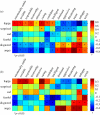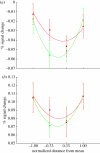Brain systems for assessing the affective value of faces
- PMID: 21536552
- PMCID: PMC3130375
- DOI: 10.1098/rstb.2010.0351
Brain systems for assessing the affective value of faces
Abstract
Cognitive neuroscience research on facial expression recognition and face evaluation has proliferated over the past 15 years. Nevertheless, large questions remain unanswered. In this overview, we discuss the current understanding in the field, and describe what is known and what remains unknown. In §2, we describe three types of behavioural evidence that the perception of traits in neutral faces is related to the perception of facial expressions, and may rely on the same mechanisms. In §3, we discuss cortical systems for the perception of facial expressions, and argue for a partial segregation of function in the superior temporal sulcus and the fusiform gyrus. In §4, we describe the current understanding of how the brain responds to emotionally neutral faces. To resolve some of the inconsistencies in the literature, we perform a large group analysis across three different studies, and argue that one parsimonious explanation of prior findings is that faces are coded in terms of their typicality. In §5, we discuss how these two lines of research--perception of emotional expressions and face evaluation--could be integrated into a common, cognitive neuroscience framework.
Figures





Similar articles
-
Specific and common brain regions involved in the perception of faces and bodies and the representation of their emotional expressions.Soc Neurosci. 2009;4(2):101-20. doi: 10.1080/17470910701865367. Soc Neurosci. 2009. PMID: 19255912
-
Distributed and interactive brain mechanisms during emotion face perception: evidence from functional neuroimaging.Neuropsychologia. 2007 Jan 7;45(1):174-94. doi: 10.1016/j.neuropsychologia.2006.06.003. Epub 2006 Jul 18. Neuropsychologia. 2007. PMID: 16854439 Review.
-
Virtual lesion of right posterior superior temporal sulcus modulates conscious visual perception of fearful expressions in faces and bodies.Cortex. 2015 Apr;65:184-94. doi: 10.1016/j.cortex.2015.01.012. Epub 2015 Feb 7. Cortex. 2015. PMID: 25835522
-
Structural resemblance to emotional expressions predicts evaluation of emotionally neutral faces.Emotion. 2009 Apr;9(2):260-4. doi: 10.1037/a0014681. Emotion. 2009. PMID: 19348537 Clinical Trial.
-
[Processing mechanism of social cues in faces].Sheng Li Xue Bao. 2019 Feb 25;71(1):73-85. Sheng Li Xue Bao. 2019. PMID: 30778506 Review. Chinese.
Cited by
-
Facing changes and changing faces in adolescence: a new model for investigating adolescent-specific interactions between pubertal, brain and behavioral development.Dev Cogn Neurosci. 2012 Apr;2(2):199-219. doi: 10.1016/j.dcn.2011.07.016. Epub 2011 Aug 17. Dev Cogn Neurosci. 2012. PMID: 22483070 Free PMC article. Review.
-
Subclinical paranoid beliefs and enhanced neural response during processing of unattractive faces.Neuroimage Clin. 2020;27:102269. doi: 10.1016/j.nicl.2020.102269. Epub 2020 Apr 25. Neuroimage Clin. 2020. PMID: 32413810 Free PMC article.
-
Neural markers of emotional face perception across psychotic disorders and general population.J Abnorm Psychol. 2017 Jul;126(5):663-678. doi: 10.1037/abn0000279. Epub 2017 May 29. J Abnorm Psychol. 2017. PMID: 28557508 Free PMC article.
-
Emotion recognition deficits as predictors of transition in individuals at clinical high risk for schizophrenia: a neurodevelopmental perspective.Psychol Med. 2015 Oct;45(14):2959-73. doi: 10.1017/S0033291715000902. Epub 2015 Jun 4. Psychol Med. 2015. PMID: 26040537 Free PMC article.
-
Selectivity of face aftereffects for expressions and anti-expressions.Front Psychol. 2012 Jan 24;3:4. doi: 10.3389/fpsyg.2012.00004. eCollection 2012. Front Psychol. 2012. PMID: 22291677 Free PMC article.
References
-
- Todorov A. 2008. Evaluating faces on trustworthiness: an extension of systems for recognition of emotions signaling approach/avoidance behaviors. Year Cogn. Neurosci. 1124, 208–224 - PubMed
-
- Said C. P., Dotsch R., Todorov A. 2010. The amygdala and FFA track both social and non-social face dimensions. Neuropsychologia 3596–360510.1016/j.neuropsychologia.2010.08.009 (doi:10.1016/j.neuropsychologia.2010.08.009) - DOI - DOI - PubMed
-
- Olivola C. Y., Todorov A. 2010. Fooled by first impressions? Reexamining the diagnostic value of appearance-based inferences. J. Exp. Social Psychol. 46, 315–32410.1016/j.jesp.2009.12.002 (doi:10.1016/j.jesp.2009.12.002) - DOI - DOI
-
- Willis J., Todorov A. 2006. First impressions: making up your mind after a 100-ms exposure to a face. Psychol. Sci. 17, 592–59810.1111/j.1467-9280.2006.01750.x (doi:10.1111/j.1467-9280.2006.01750.x) - DOI - DOI - PubMed
-
- Zebrowitz L. A., Montepare J. M. 2008. Social psychological face perception: why appearance matters. Soc. Pers. Psychol. Compass 2, 1497–151710.1111/j.1751-9004.2008.00109.x (doi:10.1111/j.1751-9004.2008.00109.x) - DOI - DOI - PMC - PubMed
Publication types
MeSH terms
LinkOut - more resources
Full Text Sources
Miscellaneous

